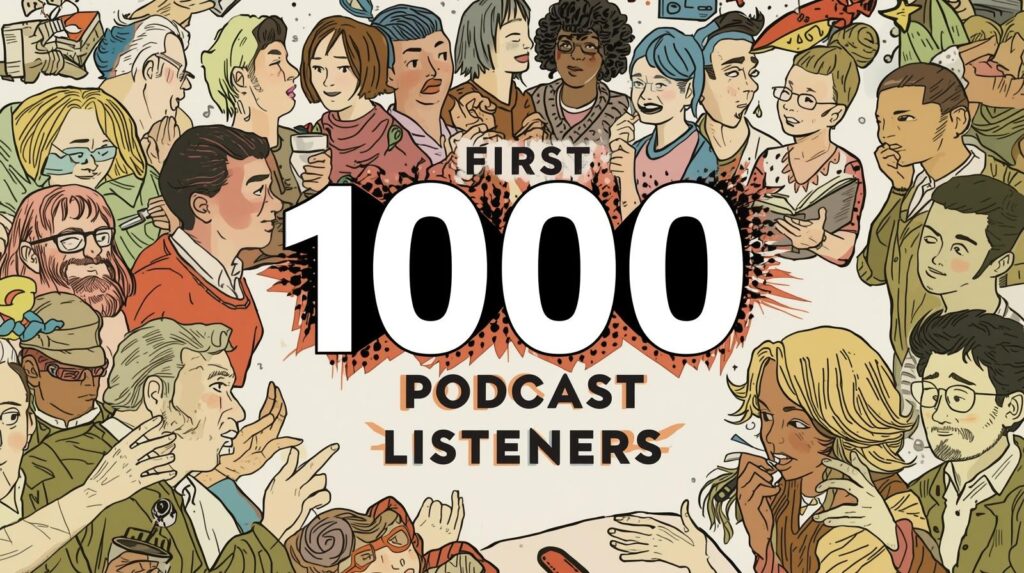Launching a podcast is exciting, but the frustration of speaking into the microphone week after week without an audience is real. Many beginner podcasters hit a wall: they’ve done the hard work of recording episodes, editing them late into the night, and publishing on a schedule—only to see a handful of downloads. It feels discouraging, like shouting into the void.
The truth is, building an audience takes more than great content. Visibility is the missing piece, and that’s where strategy comes in. The good news? You don’t need to be a marketing expert or spend thousands of dollars on ads. With the right mix of beginner-friendly, realistic, and scalable tactics, you can steadily grow your listener base.
In this guide, you’ll discover 25 proven ways to get your first 1,000 podcast listeners. These aren’t theoretical ideas—they’re actionable steps that real podcasters use to grow their shows. From optimizing your podcast title for search, to collaborating with other creators, to smart ways to repurpose your content, each tactic will help you attract new listeners and keep them coming back.
Your first 1,000 listeners are closer than you think. Let’s dive in.
1. Optimize Your Podcast Title for Search
Your podcast title is the first thing potential listeners see. A clever name might feel fun, but if it doesn’t communicate what your podcast is about, you’re making discovery harder. Include keywords people might type when searching for your topic.
Why It Works:
- Search engines and podcast directories use titles to index your show.
- Clear, keyword-rich titles improve discoverability.
How to Do It:
- Brainstorm phrases your ideal listener would search for.
- Add descriptive words (e.g., “The Fitness for Beginners Podcast” instead of “The Pump”).
- Test clarity by asking a friend if they know the topic just from the title.
2. Submit to Multiple Podcast Directories
Publishing only on Spotify or Apple Podcasts limits your reach. People use different platforms, so being everywhere increases your chances of discovery.
Why It Works:
- Expands your reach to wider audiences.
- Boosts SEO with multiple backlinks.
How to Do It:
- Distribute via hosting platforms like Buzzsprout, Podbean, or Anchor that auto-submit to directories.
- Manually add your show to directories like Goodpods, Listen Notes, or Pocket Casts.
- Keep track of where you’re listed.
3. Leverage Social Media Platforms
Your listeners likely hang out on platforms like Instagram, TikTok, Twitter, or LinkedIn. Sharing snippets, quotes, and behind-the-scenes content helps draw attention to your podcast.
Why It Works:
- Meets your audience where they already spend time.
- Visuals and short-form content increase shareability.
How to Do It:
- Create short teaser clips from episodes.
- Use tools like Headliner or Descript to make audiograms.
- Post consistently and engage with comments.
4. Ask Guests to Share Episodes
Guests bring credibility and their own audience. When they share their episode, you instantly tap into a new pool of listeners.
Why It Works:
- Expands reach through trusted voices.
- Social proof builds credibility.
How to Do It:
- Provide guests with ready-made share assets (audiograms, graphics, captions).
- Politely remind them to share when the episode goes live.
- Tag them on social media for easy resharing.
5. Optimize Episode Titles & Descriptions
Episode titles are mini hooks. A vague title like “Episode 7: Sarah Smith” tells listeners nothing. A title like “How Sarah Smith Tripled Her Business Using Instagram Reels” sparks curiosity.
Why It Works:
- Attracts clicks in podcast apps.
- Helps episodes rank in search results.
How to Do It:
- Use specific, benefit-driven language.
- Add keywords naturally.
- Write engaging, scannable descriptions with key takeaways.
6. Create Audiograms and Share Clips
Audiograms (visualized audio clips) make your content shareable. They work especially well on Instagram, TikTok, and LinkedIn.
Why It Works:
- Engages both audio and visual learners.
- Stops scrolls in social feeds.
How to Do It:
- Choose a 30–60 second engaging moment.
- Use tools like Headliner, Wavve, or Canva.
- Add captions so people can follow without sound.
7. Collaborate with Other Podcasters
Cross-promotion helps you tap into audiences who already listen to podcasts.
Why It Works:
- Builds credibility through association.
- Introduces you to targeted, podcast-friendly audiences.
How to Do It:
- Swap promo spots at the end of episodes.
- Appear as guests on each other’s shows.
- Collaborate on joint episodes.
8. Use Email Marketing & Newsletters
Email is one of the most direct ways to reach your audience. Sending episode updates keeps listeners engaged.
Why It Works:
- Delivers episodes straight to inboxes.
- Builds a loyal community beyond platforms.
How to Do It:
- Collect emails with a simple lead magnet (like a resource guide).
- Use free tools like Mailchimp or ConvertKit.
- Send engaging newsletters with episode highlights and bonus insights.
9. Be Consistent with Publishing
Nothing kills momentum like irregular uploads. Listeners need to know when to expect new episodes.
Why It Works:
- Builds trust and reliability.
- Encourages binge-listening.
How to Do It:
- Choose a realistic schedule (weekly, biweekly).
- Batch record episodes in advance.
- Communicate changes clearly if you shift schedules.
10. Network in Online Communities
Communities like Reddit, Facebook Groups, or LinkedIn are full of people interested in your niche.
Why It Works:
- Directly connects you with potential listeners.
- Builds authority when you add value.
How to Do It:
- Join groups aligned with your podcast topic.
- Answer questions and provide insights.
- Share your episodes naturally when relevant (not spammy).
11. Repurpose Podcast into Blog Posts or YouTube Videos
Not everyone consumes audio. Turning your podcast into written or video content multiplies reach.
Why It Works:
- Boosts SEO with blog posts.
- Taps into YouTube’s massive search audience.
How to Do It:
- Write show notes as detailed blog posts.
- Create YouTube videos with audio plus visuals.
- Add transcripts for accessibility.
12. Tap Into Paid Ads (Strategically)
Ads can accelerate growth if used wisely. Platforms like Facebook, Instagram, or Google let you target niche audiences.
Why It Works:
- Reaches people beyond your organic following.
- Allows precise targeting (interests, locations).
How to Do It:
- Start with a small budget ($5–$10/day).
- Promote your best-performing episodes.
- Test different ad creatives and audiences.
13. Use Strong Calls to Action
If you don’t ask listeners to subscribe, rate, or share, many won’t think to.
Why It Works:
- Encourages engagement.
- Boosts rankings in directories.
How to Do It:
- Add short CTAs at the beginning and end of episodes.
- Keep it simple: “Subscribe for free weekly tips.”
- Rotate asks (subscribe, share, review).
14. Engage in Guest Blogging
Writing articles on popular blogs gets you in front of a bigger audience.
Why It Works:
- Leverages other platforms’ audiences.
- Builds backlinks to your show.
How to Do It:
- Pitch guest posts related to your niche.
- Include a link to your podcast in your bio.
- Repurpose podcast insights into articles.
15. Optimize Show Notes for SEO
Show notes aren’t just for summaries—they’re SEO opportunities.
Why It Works:
- Helps episodes rank in Google.
- Drives long-term discovery.
How to Do It:
- Use descriptive headings and subheadings.
- Add keywords naturally.
- Link to resources and related content.
16. Offer Free Resources
Give listeners something extra, like a downloadable checklist or mini-guide.
Why It Works:
- Incentivizes email sign-ups.
- Adds extra value beyond the podcast.
How to Do It:
- Create a simple PDF guide in Canva.
- Promote it within episodes.
- Send it in exchange for email addresses.
17. Use Podcast SEO Tools
Podcast SEO tools like Podscribe or Chartable help you optimize.
Why It Works:
- Improves discoverability.
- Tracks performance for smart adjustments.
How to Do It:
- Research keywords with free tools (Ubersuggest, Ahrefs).
- Add transcripts for keyword indexing.
- Track where listeners come from.
18. Attend Podcasting Events
Networking offline builds relationships that turn into listeners.
Why It Works:
- Builds credibility.
- Creates collaboration opportunities.
How to Do It:
- Attend local meetups or virtual summits.
- Share your show when introducing yourself.
- Offer to collaborate with peers.
19. Build a Podcast Website
A central hub makes your show more professional and discoverable.
Why It Works:
- Improves SEO.
- Gives you control over branding.
How to Do It:
- Create a simple site with WordPress, Wix, or Squarespace.
- Include an about page, player, and blog.
- Optimize pages with podcast keywords.
20. Join Podcast Directories with Reviews
Platforms like Podchaser let users review shows, boosting social proof.
Why It Works:
- Builds credibility.
- Encourages new listeners to try your show.
How to Do It:
- Claim your profile on review-based directories.
- Encourage fans to leave honest reviews.
- Share positive reviews on social media.
21. Collaborate with Influencers
Even micro-influencers can amplify your reach.
Why It Works:
- Taps into loyal follower bases.
- Adds credibility by association.
How to Do It:
- Reach out to niche influencers.
- Offer value first (feature them as guests).
- Ask for shoutouts in exchange.
22. Analyze Your Metrics Regularly
Data shows what’s working—and what isn’t.
Why It Works:
- Lets you double down on winning tactics.
- Saves time by cutting ineffective strategies.
How to Do It:
- Check analytics in your host dashboard.
- Track downloads, retention, and sources.
- Adjust strategy based on performance.
23. Create a Signature Segment
Memorable segments make your show stand out.
Why It Works:
- Increases listener loyalty.
- Makes sharing easier (“Check out their lightning round!”).
How to Do It:
- Add a recurring feature (Q&A, rapid fire).
- Brand it with a fun name.
- Promote it in social snippets.
24. Run a Giveaway or Contest
Giveaways create buzz and incentivize shares.
Why It Works:
- Encourages engagement.
- Attracts new listeners through word-of-mouth.
How to Do It:
- Offer relevant prizes (books, gift cards).
- Make entry simple (subscribe + screenshot).
- Announce winners on your show.
25. Stay Patient and Persistent
Podcast growth compounds over time. Your job is to keep showing up.
Why It Works:
- Consistency builds trust.
- Small wins snowball into big results.
How to Do It:
- Commit to a minimum of 20 episodes.
- Focus on steady improvement.
- Celebrate milestones along the way.
Conclusion
Getting your first 1,000 podcast listeners may feel daunting, but it’s absolutely within reach. By combining multiple strategies—like optimizing your titles, leveraging guests, sharing on social platforms, and repurposing content—you’ll create a steady flow of new listeners.
The key is consistency and patience. Growth won’t happen overnight, but every action you take compounds. Think of it like stacking bricks: each strategy adds another layer to your audience foundation.
Pick 3–5 tactics from this list and implement them today. With focus and persistence, your first 1,000 listeners are not just possible—they’re inevitable. Keep going. Your voice deserves to be heard.


